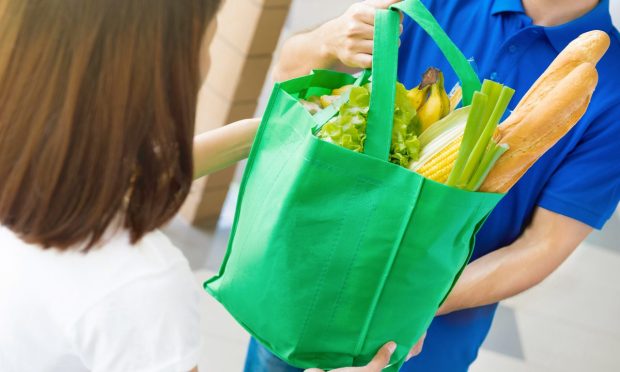Ultra-Fast Grocery Delivery Companies Expect a Future of Consolidation

Where once consumers were impressed to have groceries delivered to their homes the next day, now online shoppers are expecting quicker and quicker fulfillment. Incumbents and newcomers alike are racing to meet these on-demand expectations. In 2020, FreshDirect launched two-hour delivery in select markets, and in May, Instacart launched a 30-minute delivery feature. Meanwhile, a host of startups are emerging, promising to have groceries at consumers’ doors in as little as 15 or even 10 minutes.
One new player in the space is Buyk, a 15-minute grocery delivery service started by the founders of Russia’s Samokat express food and essentials delivery service, which launched in New York in late August. The company aims to differentiate itself with its experience in the space, which empowers the company to expand more quickly and successfully, Co-founder and CEO Slava Bocharov told PYMNTS in an interview.
“Rapid expansion is key to gaining market share, and our operational experience allows us to expand quicker and more efficiently than our competitors,” said Bocharov. “With Samokat, we launched over 800 dark stores in only two years, and in NYC we are rolling out our services rapidly … We have a proven business model that allows us to achieve the goal of turning a profit quickly on a store-by-store basis, something that has eluded almost all our peers in the ultrafast delivery market.”
The service currently has a presence in select neighborhoods across Manhattan, Brooklyn, Queens and the Bronx, and the company aims to be available throughout all five boroughs before the end of the year. By the third quarter of 2022, the company aims to have over 480 dark stores across New York, Los Angeles, Chicago and other major U.S. cities.
Already Onboard
Bocharov said he was surprised at how quickly after its launch consumers adopted the service, noting that the company is already, seven weeks after its launch, beginning to see distinct segments of different ordering behavior emerge.
“One customer cohort is already placing orders three or more times a month, while another is consistently using Buyk twice daily, once in the morning and once in the evening,” he said.
Research from PYMNTS’ report, What Consumers Expect From Their Grocery Shopping Experiences, produced in collaboration with ACI Worldwide, found that 34% of grocery shoppers buy online, and 18% rank eCommerce as their most preferred grocery shopping method. Additionally, this census-balanced survey of over 2,300 U.S. consumers, conducted in June 2021, found that 76% of consumers who have been buying their groceries online more often are doing so because they believe it is easier and more convenient, and 57% do so because it is faster.
See also: Digital Features Can Help Grocers Win Over 43% of Shoppers
“We genuinely believe that real-time retail is an important and revolutionary development across the retail and grocery sector,” he said.
Out of Many, Few
There has been an explosion of these ultrafast delivery services in recent months. In New York, for instance, consumers who want items delivered in under 20 minutes can choose between Buyk, Fridge No More, Jokr and Gorillas.
“The current situation is unsustainable and largely subsidized by a huge amount of capital investment,” said Bocharov.
He predicted that, over the next year or two, it will become clear that supply has outpaced demand, and there will be a winnowing period. He believes that investors will see that these investments are not paying off, and without these subsidies, smaller companies will be put in a position where there only remaining option is to be acquired by leaders in the space.
He argues that this proliferation is a result of misconceptions about the business model, with less experienced entrepreneurs believing that it is an easy space both to enter and to thrive in.
“While it may be true that barriers to entry are low, barriers to success are very high,” he said.
He noted that, with Samokat, the company has been refining its technology over more than four years of operating its service as well as learning how to optimize its margins.
The Water Well Effect
In the next five years, Bocharov believes that ultra-fast delivery will grow to comprise a much larger share of the overall grocery industry, powered by new automated technologies that will make the model more efficient.
This is likely true for packaged food products and nonfood items, though it may be a long time before consumers have enough trust in eGrocers to make online shopping their preferred way to buy fresh produce and meat. The Omnichannel Grocery Report, a PYMNTS and ACI Worldwide collaboration from late 2020, found that 83% of consumers prefer to buy fresh fruits and vegetables in stores, and 81% prefer to buy fresh meats the same way, compared to just 68% who prefer to buy packaged food products in stores.
Read more: In-Store Grocery Shopping Melds With Digital Payments To Nourish Commerce
Still, demand for ecommerce convenience is certainly not decreasing.
“While humans once had to fetch water from a well, we have long since developed systems to deliver this essential resource straight to taps in our homes,” Bocharov said. “We believe that, as ultrafast grocery delivery becomes more widely available, it will come to be seen as a crucial piece of infrastructure for daily life in much the same way.”
